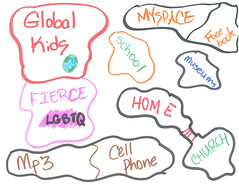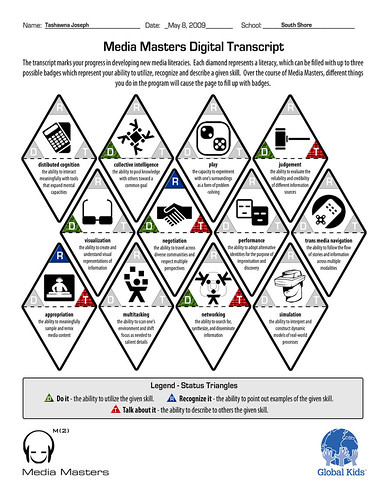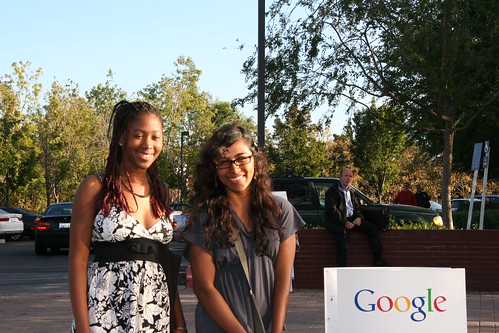
Shonette and I arrive at the GooglePlex
The Breakthrough Learning Forum wasn't at all what I expected it to be. First of all, I was under the impression I would see Google—but I didn't even get a tour! It's so funny because I was in a couple of the buildings that were a part of Google, but I didn't really get to see it as an entirety (this was me being dramatic). However, I did get to see what their employees are like when they are just hanging out with one another, or hard at work—and I also got a chance to see Sergey Brin speak. Most importantly (I think for everyone who attended) we got to experience the snacks at Google—I say this because the entire mass of snacks laid out in the morning were just about poof—gone by around 4PM. Anyway, the most impressive thing at the Googleplex for me was the T-rex that was surrounded by flamingoes!

Shonette and I with the T-Rex!
I have to admit that I was impressed with Sergey Brin—not only because he sounded smart and was smart (I think it's relatively important to separate the two), but because he said something that was strikingly true. My generation has been labeled over and over as apathetic and lazy, but Sergey, in my opinion, said something that explained the mentality a bit better. I can't quote him exactly, but he said that many of us had this existential perspective on life, and he used the example of him seeing his goals as a child as "just over the hills" whereas many of us see our goals as over a massive mountains. There is definitely a feeling of "Yes, it's possible, but definitely not probable". I'm definitely one of these people, I'm not one to see myself as someone who is any more likely to become someone extraordinary than all the other 6 billion and whatnot people. However, I do think Global Kids does try to encourage the idea that anyone has just about unlimited potential, and can attain anything and everything that they set their mind to. I can't help but admire the self-confidence and motivation of many of the Global Kids youth leaders because when one of them says that they want to be the Secretary General of the United Nations—they really do mean it and truly believe that at the end of horizon awaits their dreams. It must be an extraordinary feeling that many of us miss out on because we feel constrained by what is realistic.
I must say because of this outlook on life we end up taking for granted a lot of the things we do get to have. We have so many resources that many children around the world don't get to have—first and foremost, we have the basics: food, water, clothing, and shelter. We definitely don't have the best educational system, but we have one that'll at least require us to get some form of an education. I can't speak to for everyone, but I have been blessed with some of the most wonderful teachers and educators, ones that have gone beyond what is expected of them for me. And, I can't imagine what this would sound like to a child in a "Third World" Country, we have people that will design and attend a forum on using and incorporating digital media into the educational system. We take all of this for granted, really, and how bewildering, if not outrageous, that must sound to some child that works all day and night, and prays of having some sort of filling meal sometime soon. It must be the most amazing experiences to see one of these children smile—to hear about their dreams, to see hope in their eyes after facing all the harsh realities that could possibly exist.
I bring this up because while I was at the Forum I remembered discussing with one of the attendees that I ran an event on Teen Second Life streaming Ishmael Beah, a former child soldier, speaking about his book (and I constantly forget all the things I've done with Global Kids, so I need to come up with a list). Ishmael Beah really has one of the most cheerful smiles that I have ever seen, and it really is amazing because he has been through so much and he can still stay so optimistic and happy. So although, understanding this, I still do not consider myself any more extraordinary than the next person, I must admit that I have been given so many extraordinary opportunities thanks to Global Kids. I say this on behalf of many of the teens that have worked with Global Kids because GK definitely puts effort into giving us opportunities that not many people get to have—and I am very grateful for that. It's funny because all the opportunities that have been presented to me are always so unexpected—I definitely didn't expect an email asking, "Hey, how do you feel about attending the Breakthrough Learning Forum at the Googleplex". It didn't really occur to me that getting the opportunity to go to this event was particularly exceptional until someone said that they would give up concert tickets to see their favorite band and put down everything that's going on in their lives just to have the opportunity to go to this event. So I'm very fortunate to have the opportunity to go, especially since I got to meet a lot of great adults as well as teens.
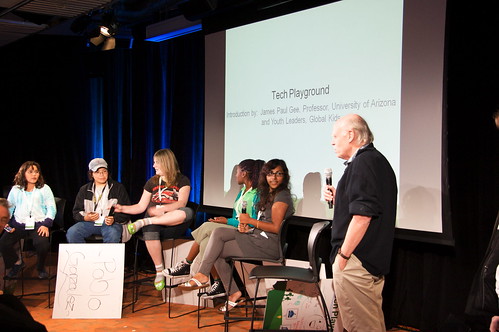
The Youth Team presents their skit about digital learning at the Forum
So of course, one of the main parts for the teens was the skit we worked on to invite the attendees to go to the Tech Playground to check out the different breakthrough learning technologies provided. The best part about this was first coming up with the skit, which actually did take some creative thinking. For those who missed it, the skit was about a bunch of teens attending a meeting of "Misunderstood Media Teens" and we all gathered together to talk about our grievances as far as adults not understanding how we use technology in our lives, and also talking about how organizations like Global Kids, Mouse, and BAVC encourage the use of different forms of digital media. Since we felt like many adults weren't listening to us, I found this application (iJim) that turned one of us into the games and learning scholar James Paul Gee. However, when one of us turned to James Gee, he realized that adults do care to listen to what younger people have to say. So we used the iTouch to time travel (using iTimeTravel) into the Breakthrough Learning Forum to ask everyone attending to join us at the Tech Playground [Disclaimer: please do not get your hopes up, technology has advanced, but not that much; therefore, these iTouch applications are not real]. I thought it was very cute, and it was fun because we got to do a lot of fake and exaggerated/amateur acting. Plus, it gave us a lot of time to interact with James Gee throughout the event, which was great because he really is an awesome character—and what I mean by that, you can only understand by meeting him. One of the things that James Gee said that I felt like I could most relate to was that we learn through failure. I definitely think it is very true—failing is a great way to learn. Especially in games, where there are really no consequences to failing and you simply play again and learn from the game itself and eventually create this formula that you use to get through the game if you choose to ever restart playing it.
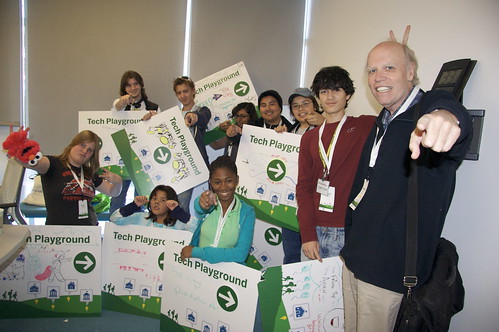
The Youth Team from Global Kids, BAVC and MOUSE with James Paul Gee
One of the presenters that really stuck out to me was Mimi Ito because she talked about how young people took their interests in digital media and completely expanded their knowledge and skills off of it. She talked about someone who was interested in Anime Music Videos, who became inspired by a video created by a fellow fan and decided to then go onto creating his own. After that he really got into the editing, and encouraged his friends to do the same—and I guess this stood out to me because I felt I could most relate to it. I do love AMV's and some of them are really wonderfully made. Plus, they are a great way to promote different animations that capture your own interest. In addition, I really like filmmaking and editing, which is why I was a part of the Virtual Video Project with Global Kids. I thought this was probably one of the best presentations as far as finding the correlation between the interests of youth with different forms of digital media. Another presentation I found interesting was by Connie Yowell from the MacArthur Foundation, when she made a comparison between a classroom "back in the day" to a modern day classroom. It was hilariously and unfortunately true. Even though technology has progressed so much, the classroom still just has a board and a bunch of chairs and tables. Maybe with the exception that we now have some dry-eraser boards instead of chalk boards. It seems that we are so busy spending and dedicating most of our national budget to the military that we forgot that the school system should eventually change (you know, perhaps improve). But I thought this was a very provoking comparison to present to the attendees.
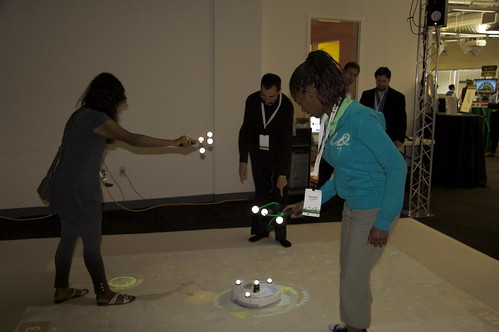
Shonette and I playing in the SmallLab
As a true Global Kid's alum, my favorite technology presented at the Tech Playground was the game from SmallLab, which was being demoed by David Birchfield (although Dana and I were the ones playing it for the longest duration of time), on water conservation. The idea of the game was to spin this robot until it released water from the reserves, which we would then have to lead to the houses. The houses would then release waste water, which we would have to lead back to the machine for recycling. Sounds simple, but it gets harder around level 6, trust me. I really liked that it was an interactive game, and it appealed to really all ages. Plus, it promoted the idea of water conservation, which is a really important thing for children to understand because water is not as much of an unlimited resource as we would like to think and there are many people out there today that do not get access to clean water. My only suggestion was that a factor be added to the game where there are houses or people that actually "steal" the clean water away—only to reflect the idea that there are many people in America that have obnoxiously huge lawns that are overly watered, especially in areas where water is limited. So I thought it would be a funny (but realistic) concept to add to it. Also, if the platform where the game is played could be made bigger, it would be great because kids are growing bigger and bigger (some of them are taller than me by 5th grade, if not 3rd) so the larger the platform is, the more it promotes exercise—and the less likely it is that your shadow will interfere as much in the game. Technologies presented at the Forum. Plus, it's wonderful to fight for water conservation and against child obesity all at the same time!
Overall, I thought attending this event was a great experience and I can't thank Global Kids enough for taking me. The only sad part of the entire thing was that we got Lava Lamps that we couldn't bring back to New York City due to airport restrictions on carry-on luggage. But hey, physical things can't compensate for experience and knowledge—but experience and knowledge can definitely compensate for any physical item. The experiences we came back with definitely outweigh the "stuff" we came back with, since stuff will eventually get thrown out or lost, but the experiences contribute to who we are and have/will become. I did meet a lot of inspirational people, and I really hope that everyone continues to work hard to incorporate technology into the educational system because it is very necessary in order for future generations to have access to better education. All parents hope that their children will accomplish more than they could, and have a better life in general—so it is only ideal that we all work hard to ensure that the educational system improves, not just for "our children" but for all children. Maybe we can all take a moment actually care for the children and not just declare that something must be done to improve their lives, and the children to come. Maybe if a political figure paid a dollar for every time they mentioned "the children" and didn't care to act upon his or her words, we could have a better educational system. Fact of the matter is, if you haven't done anything yet, and a classroom back in the day still looks the same as a modern day classroom, it is a very good time to start doing something—and that's what the entire forum was based upon.



